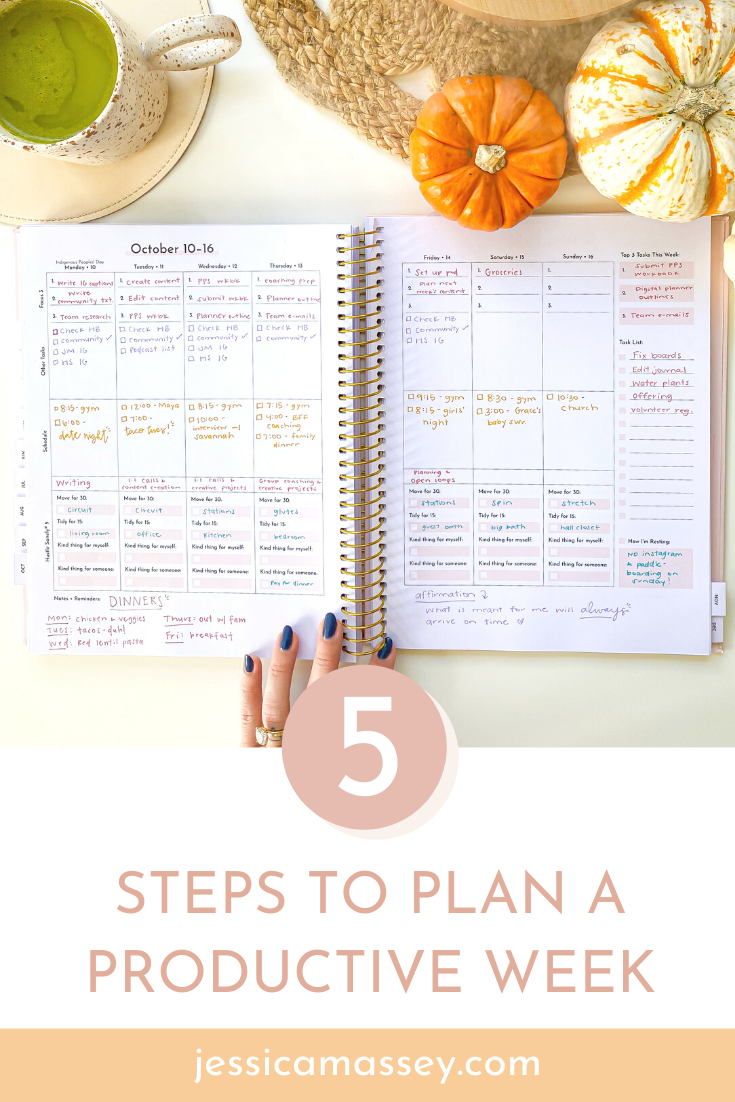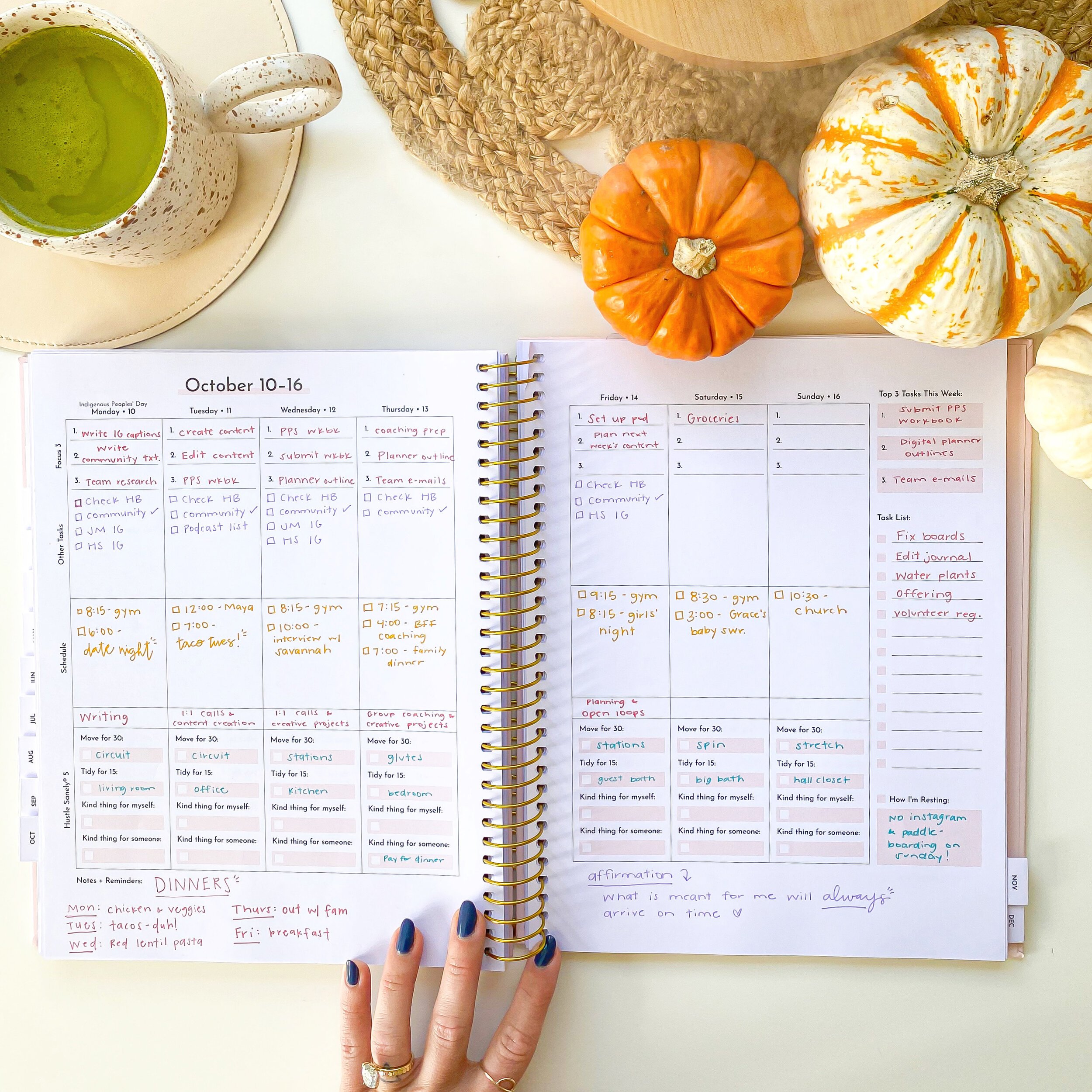How to Plan a (Peacefully) Productive Week
Wondering how to prep for your weeks without feeling frazzled, overwhelmed, or like you're forgetting something important? Well, do I have a treat for you — I’m sharing part of The 5-Step Hustle Sanely Schedule Building Framework with you today!
When I sit down for my weekly prep meeting, I follow 5 simple steps that set me up to make real progress on my goals without sacrificing my mental health and the important relationships in my life.
I can truthfully say, I never sit down and wonder what tasks need to be done every week or every day because of this framework and I’m confident that you’ll feel the same way after implementing these steps.
Keep reading this post to learn:
⋒ 5 steps to follow to plan a peacefully productive week
I sit down on Friday afternoons (it’s always my last work task for the week) with my planner and have my weekly prep meeting — which if you have the Hustle Sanely Handbook, you’ll know what I’m talking about!
Now I’ve got this down to a science because I’ve been doing it for so long but I’m going to break it down step by step for you. There are 5 steps that I follow when I’m planning out my weeks. The best part is, in the weekly 2022 Peacefully Productive Planners (which we have less than 200 left btw) all of these steps are built right into the weekly spreads. You literally just have to sit down with your planner and a pen and boom, you’ll be on your way to designing your peacefully productive week!
Here are the 5 steps to follow to plan a peacefully productive week:
01. Plug in your scheduled responsibilities.
The first thing to do is make a note of any time-bound events that you have for the week. Things like classes, meetings, and appointments, calls, anything that requires you to be somewhere at a specific time. Now in my Peacefully Productive Planner, I put these in the “schedule” area for the appropriate day and I like to use a bright color to highlight them so they stand out.
02. Plug in your non-negotiable priorities and any supporting habits.
In order to do this, you have to actually know what your non-negotiable priorities and supporting habits are. If you don’t know yours, spend some time getting clear on your vision. If you need help with that, check out the Dream It. Do It. Workshop!
Anyway, there is a monthly habit tracker in the planner that I use to make sure that I am spending my time and energy doing things that align with the vision that I have for my life. There is also a place in there to make a note of your daily, weekly, monthly, and occasional non-negotiable priorities and habits.
I’ll share some of my non-negotiables and habits with y’all so you can get your wheels turning:
- We host Taco Tuesday at our house for our friends every Tuesday (duh, lol) at 7 PM
- I visit my grandparents once a week
- My husband and I do date night once a week
- I go to the gym 5 days a week
- I have a girls’ night once a month
These are some of my non-negotiable priorities and habits and again, once you know what yours are, get them on your weekly schedule so you actually do them! When we put our non-negotiables and desired habits on the calendar, we are way more like;y to actually do them.
03. Determine and schedule your Top 3 tasks for the week.
Ask yourself what the 3 tasks are that are the most crucial to get done for the week. Going into the week already being aware of these positions you to get them done in the most prepared way possible. When you can, take it a step further and get them on your schedule as you’re planning your week.
I do this in my Peacefully Productive Planner by writing my Top 3 tasks in the top right corner of the weekly spread (there is a space dedicated to it) and then if I know which days I’m working on each one, I’ll pop those on a Focus 3 line for that specific day. Each day in the planner has a space for you to write down your Focus 3 tasks for each day.
04. Schedule your weekly rest.
Before you go wild and start filling your days with all of the other tasks that you need to get done for the week outside of your Top 3 tasks, schedule in intentional rest. In the planner, there is a space on the bottom right that says “How I’m resting” so you can keep rest at the forefront of your mind instead of being tempted to think you have to wait to earn rest after your to-do list is done. I hope you know by now that around here, we operate from a place of rest. It’s not a reward for anything!
So whether it’s an hour or an entire day, schedule in intentional rest. Rest is whatever refreshes your soul. For me, it looks like doing outdoor activities (biking, paddle boarding, rollerblading), reading, and getting dinner with friends. For you, it may look like tending to your garden, watching a movie, or going to yoga.
05. Fill in other tasks for the week, carving out space for margin + transitions.
The last step is to write down other tasks that need to get done (other than your Top 3 tasks) that week. In the planner, there is an area called “task list” so you can keep track of what needs to be done from week to week.
Now how I go about this — if I know what day something needs to be done, I’ll put it under the “Other Tasks” section for the specific day in my planner. And if I know it’s gonna be a Focus 3 task for that day, I’ll put it up on a Focus 3 line. Now if the task doesn’t have a specific day it has to be done, I just put it on the weekly task list and I use that throughout the week to help me schedule each day. I schedule my days the evening before.
As you start to make your to-do list of tasks that are outside of your Top 3 Tasks, it is a very dangerous strategy to fill every second of every day, bouncing from task to task without looking up. We are not machines. We need time to step away, collect our thoughts, change plans, and partake in unplanned rest when we need it. While it may be tempting to fill your to-do list with all the things because technically the time that each item takes fits in your allotted work window, DON’T DO IT! Oftentimes we forget to account for transition time and the energy expenditure required to complete each task.
It’s important to leave margin because that’s where life happens.
When I’m creating my routines and schedule I always account for 30 minutes as a transition time between tasks. Do I always need the full 30 minutes? No. But I like knowing that I have plenty of time to transition physically and mentally from one task to another. Plus if something takes a few minutes longer than anticipated, your entire day isn’t thrown off. The 300minute transition period is a built-in buffer for your energy preservation.
Doing this weekly prep meeting every Friday sets me up to make legit progress on my goals but without sacrificing my mental health and the important relationships in my life.
I can truthfully say, I never sit down and wonder what tasks I need to be doing every week or every day because of this framework.
Here is a peek at the weekly spread in the Peacefully Productive Planner so you can kind of visualize the steps that I explained:
Oh and let me just go ahead and give you a spoiler alert right now — this is barely skimming the surface about the stuff we cover in the Create Your Peacefully Productive Schedule course! If you really struggle with time and energy management and creating a schedule that doesn’t overwhelm you and truly reflects your priorities, mmm girl, this is the course for you!
If you enjoyed this post, tune into episode 102 of The Hustle Sanely Podcast to dive deeper into this topic:




